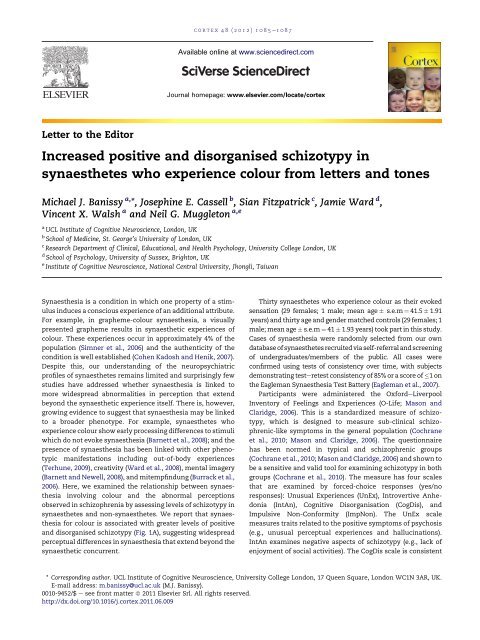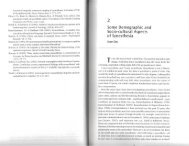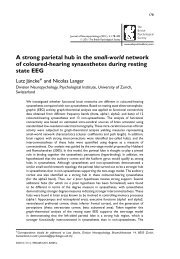Increased positive and disorganised schizotypy in ... - Synesthesia
Increased positive and disorganised schizotypy in ... - Synesthesia
Increased positive and disorganised schizotypy in ... - Synesthesia
You also want an ePaper? Increase the reach of your titles
YUMPU automatically turns print PDFs into web optimized ePapers that Google loves.
Letter to the Editor<br />
<strong>Increased</strong> <strong>positive</strong> <strong>and</strong> <strong>disorganised</strong> <strong>schizotypy</strong> <strong>in</strong><br />
synaesthetes who experience colour from letters <strong>and</strong> tones<br />
Michael J. Banissy a, *, Joseph<strong>in</strong>e E. Cassell b , Sian Fitzpatrick c , Jamie Ward d ,<br />
V<strong>in</strong>cent X. Walsh a <strong>and</strong> Neil G. Muggleton a,e<br />
a<br />
UCL Institute of Cognitive Neuroscience, London, UK<br />
b<br />
School of Medic<strong>in</strong>e, St. George’s University of London, UK<br />
c<br />
Research Department of Cl<strong>in</strong>ical, Educational, <strong>and</strong> Health Psychology, University College London, UK<br />
d<br />
School of Psychology, University of Sussex, Brighton, UK<br />
e<br />
Institute of Cognitive Neuroscience, National Central University, Jhongli, Taiwan<br />
Synaesthesia is a condition <strong>in</strong> which one property of a stimulus<br />
<strong>in</strong>duces a conscious experience of an additional attribute.<br />
For example, <strong>in</strong> grapheme-colour synaesthesia, a visually<br />
presented grapheme results <strong>in</strong> synaesthetic experiences of<br />
colour. These experiences occur <strong>in</strong> approximately 4% of the<br />
population (Simner et al., 2006) <strong>and</strong> the authenticity of the<br />
condition is well established (Cohen Kadosh <strong>and</strong> Henik, 2007).<br />
Despite this, our underst<strong>and</strong><strong>in</strong>g of the neuropsychiatric<br />
profiles of synaesthetes rema<strong>in</strong>s limited <strong>and</strong> surpris<strong>in</strong>gly few<br />
studies have addressed whether synaesthesia is l<strong>in</strong>ked to<br />
more widespread abnormalities <strong>in</strong> perception that extend<br />
beyond the synaesthetic experience itself. There is, however,<br />
grow<strong>in</strong>g evidence to suggest that synaesthesia may be l<strong>in</strong>ked<br />
to a broader phenotype. For example, synaesthetes who<br />
experience colour show early process<strong>in</strong>g differences to stimuli<br />
which do not evoke synaesthesia (Barnett et al., 2008); <strong>and</strong> the<br />
presence of synaesthesia has been l<strong>in</strong>ked with other phenotypic<br />
manifestations <strong>in</strong>clud<strong>in</strong>g out-of-body experiences<br />
(Terhune, 2009), creativity (Ward et al., 2008), mental imagery<br />
(Barnett <strong>and</strong> Newell, 2008), <strong>and</strong> mitempf<strong>in</strong>dung (Burrack et al.,<br />
2006). Here, we exam<strong>in</strong>ed the relationship between synaesthesia<br />
<strong>in</strong>volv<strong>in</strong>g colour <strong>and</strong> the abnormal perceptions<br />
observed <strong>in</strong> schizophrenia by assess<strong>in</strong>g levels of <strong>schizotypy</strong> <strong>in</strong><br />
synaesthetes <strong>and</strong> non-synaesthetes. We report that synaesthesia<br />
for colour is associated with greater levels of <strong>positive</strong><br />
<strong>and</strong> <strong>disorganised</strong> <strong>schizotypy</strong> (Fig. 1A), suggest<strong>in</strong>g widespread<br />
perceptual differences <strong>in</strong> synaesthesia that extend beyond the<br />
synaesthetic concurrent.<br />
cortex 48 (2012) 1085e1087<br />
Available onl<strong>in</strong>e at www.sciencedirect.com<br />
Journal homepage: www.elsevier.com/locate/cortex<br />
Thirty synaesthetes who experience colour as their evoked<br />
sensation (29 females; 1 male; mean age s.e.m ¼ 41.5 1.91<br />
years) <strong>and</strong> thirty age <strong>and</strong> gender matched controls (29 females; 1<br />
male; mean age s.e.m ¼ 41 1.93 years) took part <strong>in</strong> this study.<br />
Cases of synaesthesia were r<strong>and</strong>omly selected from our own<br />
database of synaesthetes recruited via self-referral <strong>and</strong> screen<strong>in</strong>g<br />
of undergraduates/members of the public. All cases were<br />
confirmed us<strong>in</strong>g tests of consistency over time, with subjects<br />
demonstrat<strong>in</strong>g testeretest consistency of 85% or a score of 1on<br />
the Eagleman Synaesthesia Test Battery (Eagleman et al., 2007).<br />
Participants were adm<strong>in</strong>istered the OxfordeLiverpool<br />
Inventory of Feel<strong>in</strong>gs <strong>and</strong> Experiences (O-Life; Mason <strong>and</strong><br />
Claridge, 2006). This is a st<strong>and</strong>ardized measure of <strong>schizotypy</strong>,<br />
which is designed to measure sub-cl<strong>in</strong>ical schizophrenic-like<br />
symptoms <strong>in</strong> the general population (Cochrane<br />
et al., 2010; Mason <strong>and</strong> Claridge, 2006). The questionnaire<br />
has been normed <strong>in</strong> typical <strong>and</strong> schizophrenic groups<br />
(Cochrane et al., 2010; Mason <strong>and</strong> Claridge, 2006) <strong>and</strong> shown to<br />
be a sensitive <strong>and</strong> valid tool for exam<strong>in</strong><strong>in</strong>g <strong>schizotypy</strong> <strong>in</strong> both<br />
groups (Cochrane et al., 2010). The measure has four scales<br />
that are exam<strong>in</strong>ed by forced-choice responses (yes/no<br />
responses): Unusual Experiences (UnEx), Introvertive Anhedonia<br />
(IntAn), Cognitive Disorganisation (CogDis), <strong>and</strong><br />
Impulsive Non-Conformity (ImpNon). The UnEx scale<br />
measures traits related to the <strong>positive</strong> symptoms of psychosis<br />
(e.g., unusual perceptual experiences <strong>and</strong> halluc<strong>in</strong>ations).<br />
IntAn exam<strong>in</strong>es negative aspects of <strong>schizotypy</strong> (e.g., lack of<br />
enjoyment of social activities). The CogDis scale is consistent<br />
* Correspond<strong>in</strong>g author. UCL Institute of Cognitive Neuroscience, University College London, 17 Queen Square, London WC1N 3AR, UK.<br />
E-mail address: m.banissy@ucl.ac.uk (M.J. Banissy).<br />
0010-9452/$ e see front matter ª 2011 Elsevier Srl. All rights reserved.<br />
http://dx.doi.org/10.1016/j.cortex.2011.06.009
1086<br />
Fig. 1 e (A) Synaesthetes showed higher levels of <strong>positive</strong> (UnEx) <strong>and</strong> <strong>disorganised</strong> <strong>schizotypy</strong> (CogDis) relative to matched<br />
control participants, but did not significantly differ on negative <strong>schizotypy</strong> (IntAn) or ImpNon. ± s.e.m. * [ p < .05. (B)<br />
Frequency of scores on the UnEx scale for synaesthetes (control mean shown as dashed l<strong>in</strong>e). (C) Frequency of scores on the<br />
CogDis scale for synaesthetes (control mean shown as dashed l<strong>in</strong>e).<br />
with thought disorder <strong>and</strong> <strong>disorganised</strong> aspects of psychosis,<br />
it is comprised of items measur<strong>in</strong>g problems with decisionmak<strong>in</strong>g<br />
<strong>and</strong> social anxiety. F<strong>in</strong>ally, the ImpNon scale exam<strong>in</strong>es<br />
impulsive, antisocial <strong>and</strong> eccentric forms of behaviour<br />
(Cochrane et al., 2010; Mason <strong>and</strong> Claridge, 2006).<br />
A 2 (Group) 4 (Schizotypal Factor) mixed ANOVA was<br />
used to explore differences on each component of <strong>schizotypy</strong><br />
between the groups. A ma<strong>in</strong> effect of group was observed<br />
[F(1, 58) ¼ 7.49, p ¼
these cognitive manifestations (e.g., Barnett <strong>and</strong> Newell, 2008;<br />
Ward et al., 2008). Therefore, <strong>in</strong> conjunction with mental<br />
imagery <strong>and</strong> creativity, <strong>in</strong>creased <strong>positive</strong> <strong>and</strong> <strong>disorganised</strong><br />
<strong>schizotypy</strong> may reflect a constellation of trait markers that are<br />
l<strong>in</strong>ked to synaesthesia. In this context, it is <strong>in</strong>terest<strong>in</strong>g to note<br />
that one mechanism that has been suggested to expla<strong>in</strong> the<br />
relationship between <strong>in</strong>creased <strong>schizotypy</strong> <strong>and</strong> both creativity<br />
<strong>and</strong> mental imagery is a difference <strong>in</strong> levels of <strong>in</strong>hibition/<br />
excitation (e.g., Grossberg, 2000; Nelson <strong>and</strong> Rawl<strong>in</strong>gs, 2010). A<br />
similar hypothesis has been suggested as a mechanism<br />
contribut<strong>in</strong>g towards synaesthesia (Grossenbacher <strong>and</strong><br />
Lovelace, 2001; Brang <strong>and</strong> Ramach<strong>and</strong>ran, 2008). While, as<br />
yet, there is a lack of direct evidence exam<strong>in</strong><strong>in</strong>g differences <strong>in</strong><br />
cortical <strong>in</strong>hibition <strong>in</strong> synaesthesia, this offers one plausible<br />
mechanism of neural development that may associate<br />
synaesthesia, <strong>schizotypy</strong>, creativity <strong>and</strong> mental imagery.<br />
Del<strong>in</strong>eat<strong>in</strong>g the relative contributions that extended cognitive<br />
manifestations <strong>and</strong> alterations <strong>in</strong> neural development have on<br />
the relationship between synaesthesia <strong>and</strong> <strong>schizotypy</strong> will<br />
provide important <strong>in</strong>sights <strong>in</strong>to the mechanisms that mediate<br />
the developmental of typical <strong>and</strong> atypical perceptual<br />
experiences.<br />
Acknowledgements<br />
MJB is supported by a British Academy Postdoctoral Fellowship.<br />
This work was partly supported by an MRC grant to VW.<br />
references<br />
Barnett KJ, Foxe JJ, Molholm S, Kelly SP, Shalgi S, Mitchell KJ, et al.<br />
Differences <strong>in</strong> early sensory-perceptual process<strong>in</strong>g <strong>in</strong><br />
synesthesia: A visual evoked potential study. NeuroImage,<br />
43(3): 605e613, 2008.<br />
cortex 48 (2012) 1085e1087 1087<br />
Barnett K <strong>and</strong> Newell FN. Synaesthesia is associated with<br />
enhanced, self rated imagery. Consciousness <strong>and</strong> Cognition,<br />
17(3): 1032e1039, 2008.<br />
Brang D <strong>and</strong> Ramach<strong>and</strong>ran VS. Psychopharmacology of<br />
synesthesia; the role of seroton<strong>in</strong> S2a receptor activation.<br />
Medical Hypotheses, 70(4): 903e904, 2008.<br />
Burrack A, Knoch D, <strong>and</strong> Brugger P. Mitempf<strong>in</strong>dung <strong>in</strong><br />
synaesthetes: Co-<strong>in</strong>cidence or mean<strong>in</strong>gful association.<br />
Cortex, 42(2):151e154, 2006.<br />
Cochrane M, Petch I, <strong>and</strong> Picker<strong>in</strong>g AD. Do measures of<br />
schizotypal personality provide non-cl<strong>in</strong>ical analogues of<br />
schizophrenic symptomatology. Psychiatry Research, 176(2e3):<br />
150e154, 2010.<br />
CohenKadoshR<strong>and</strong>HenikA.Cansynaesthesiaresearch<strong>in</strong>form<br />
cognitive science? Trends <strong>in</strong> Cognitive Sciences, 11(4): 177e184, 2007.<br />
Eagleman DM, Kagan AD, Nelson SS, Sagaram D, <strong>and</strong> Sarma AK. A<br />
st<strong>and</strong>ardized test battery for the study of synesthesia. Journal<br />
of Neuroscience Methods, 159(1): 139e145, 2007.<br />
Grossberg S. How halluc<strong>in</strong>ations may arise from bra<strong>in</strong><br />
mechanisms of learn<strong>in</strong>g, attention, <strong>and</strong> volition. Journal of the<br />
International Neuropsychological Society, 6(5): 583e592, 2000.<br />
Grossenbacher PG <strong>and</strong> Lovelace CT. Mechanisms of synesthesia:<br />
Cognitive <strong>and</strong> physiological constra<strong>in</strong>ts. Trends <strong>in</strong> Cognitive<br />
Sciences, 5(1): 36e41, 2001.<br />
Mason O <strong>and</strong> Claridge G. The OxfordeLiverpool <strong>in</strong>ventory of<br />
feel<strong>in</strong>gs <strong>and</strong> experiences (O-LIFE): Further descriptions <strong>and</strong><br />
extended norms. Schizophrenia Research, 82(2e3): 203e211, 2006.<br />
Nelson B <strong>and</strong> Rawl<strong>in</strong>gs D. Relat<strong>in</strong>g <strong>schizotypy</strong> <strong>and</strong> personality to<br />
the phenomenology of creativity. Schizophrenia Bullet<strong>in</strong>, 36(2):<br />
388e399, 2010.<br />
Oertel V, Rotarska-Jagiela A, van de Ven V, Haenschel C, Grube M,<br />
Stangier U, et al. Mental imagery vividness as a trait marker<br />
across the schizophrenia spectrum. Psychiatry Research,<br />
167(1e2): 1e11, 2009.<br />
Simner J, Mulvenna C, Sagiv N, Tsakanikos E, Witherby SA,<br />
Fraser C, et al. Synaesthesia: The prevalence of atipica crossmodal<br />
experiences. Perception, 35(8): 1024e1033, 2006.<br />
Terhune DB. The <strong>in</strong>cidence <strong>and</strong> determ<strong>in</strong>ants of visual<br />
phenomenology dur<strong>in</strong>g out-of-body experiences. Cortex,<br />
45(2): 236e242, 2009.<br />
Ward J, Thompson-Lake D, Ely R, <strong>and</strong> Kam<strong>in</strong>ski F. Synaesthesia,<br />
creativity <strong>and</strong> art: What is the l<strong>in</strong>k? British Journal of Psychology,<br />
99(Pt1): 127e141, 2008.




